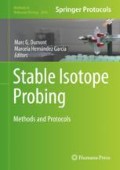Abstract
Stable isotope probing of microbial nucleic acids applied in the rhizosphere enables (a) the identification of the active microbial community involved in root exudate assimilation and those involved in soil organic matter degradation, and (b) the study of the impact of plants via root exudates on the in situ expression of microbial functions. By incubating plants under 13CO2, fresh carbon exuded by the plant will be labeled and hence the microbial community assimilating 13C-root exudates will incorporate 13C into their cellular macromolecules. Labeled DNA, RNA, and proteins can be used to identify microorganisms that assimilated the root exudates. We provide a step-by-step protocol on how to apply stable isotope probing of DNA and RNA in the plant rhizosphere to identify the active microbial communities and analyze their gene expression.
Access this chapter
Tax calculation will be finalised at checkout
Purchases are for personal use only
References
Bulgarelli D, Rott M, Schlaeppi K et al (2012) Revealing structure and assembly cues for Arabidopsis root-inhabiting bacterial microbiota. Nature 488:91–95
Haichar FZ, Santaella C, Heulin T et al (2014) Root exudates mediated interactions belowground. Soil Biol Biochem 77:69–80
Knief C, Delmotte N, Chaffron S et al (2012) Metaproteogenomic analysis of microbial communities in the phyllosphere and rhizosphere of rice. ISME J 6:1378–1390
Bulgarelli D, Schlaeppi K, Spaepen S et al (2013) Structure and functions of the bacterial microbiota of plants. Annu Rev Plant Biol 64:807–838
Hiltner L (1904) Uber neuere Erfahrungen und Problem auf dem gebiet der Bod- enbakteriologie und unter besonderer Berücksichtigung der Gründüngung und Brachte. Arb Dt Landwges 98:59e78
Guyonnet JP, Vautrin F, Meiffren G et al (2017) The effects of plant nutritional strategy on soil microbial denitrification activity through rhizosphere primary metabolites. FEMS Microbiol Ecol 93(4):fix022
Guyonnet JP, Cantarel AAM, Simon L et al (2018) Root exudation rate as a functional trait involved in plant nutrient-use strategy classification. Ecol Evol 8(16):8573–8581
Dumont MG, Murrell JC (2005) Stable isotope probing linking microbial identity to function. Nat Rev Microbiol 3:499–504
Prosser JI, Rangel-Castro JI, Killhman K (2006) Studying plant-microbe interactions using stable isotope technologies. Curr Opin Biotechnol 17:98–102
Haichar FZ, Heulin T, Guyonnet JP et al (2016) Stable isotope probing of carbon flow in the plant holobiont. Curr Opin Biotechnol 41:9–13
Haichar FZ, Marol C, Berge O et al (2008) Plant host habitat and root exudates shape soil bacterial community structure. ISME J 2:1221–1230
Bressan M, Roncato MA, Bellvert F et al (2009) Exogenous glucosinolate produced by Arabidopsis thaliana has an impact on microbes in the rhizosphere and plant roots. ISME J 3:1243–1257
Rangel-Castro JI, Killham K, Ostle N et al (2005) Stable isotope probing analysis of the influence of liming on root exudates utilization by soil microorganisms. Environ Microbiol 7:828–838
Lu Y, Conrad R (2005) In situ stable isotope probing of methanogenic Archaea in the rice rhizosphere. Science 309:1088–1090
Vandenkoornhuyse P, Mahe S, Ineson P et al (2007) Active root-inhabiting microbes identified by rapid incorporation of plant-derived carbon into RNA. Proc Natl Acad Sci U S A 104:16970–16975
Haichar FZ, Roncato MA, Achouak W (2012) Stable isotope probing of bacterial community structure and gene expression in the rhizosphere of Arabidopsis thaliana. FEMS Microbiol Ecol 81:291–302
Ranjard L, Lejon DPH, Mougel C et al (2003) Sampling strategy in molecular microbial ecology: influence of soil sample size on DNA fingerprinting analysis of fungal and bacterial communities. Environ Microbiol 5:1111–1120
Manefield M, Whiteley AS, Griffiths RI et al (2002) RNA stable isotope probing, a novel means of linking microbial community function to phylogeny. Appl Environ Microbiol 68:5367–5373
Bernard L, Mougel C, Maron PA et al (2007) Dynamics and identification of soil microbial populations actively assimilating carbon from 13C-labelled wheat residue as estimated by DNA- and RNA-SIP techniques. Environ Microbiol 9:752–764
Haichar FZ, Achouak W, Christen R et al (2007) Identification of cellulolytic bacteria in soil by stable isotope probing. Environ Microbiol 9:625–634
Acknowledgments
We thank French National Research Agency (ANR-18-CE32-0005, DIORE) for providing funding to the project.
Author information
Authors and Affiliations
Corresponding author
Editor information
Editors and Affiliations
Rights and permissions
Copyright information
© 2019 Springer Science+Business Media, LLC, part of Springer Nature
About this protocol
Cite this protocol
Achouak, W., Haichar, F.e.Z. (2019). Stable Isotope Probing of Microbiota Structure and Function in the Plant Rhizosphere. In: Dumont, M., Hernández García, M. (eds) Stable Isotope Probing. Methods in Molecular Biology, vol 2046. Humana, New York, NY. https://doi.org/10.1007/978-1-4939-9721-3_18
Download citation
DOI: https://doi.org/10.1007/978-1-4939-9721-3_18
Published:
Publisher Name: Humana, New York, NY
Print ISBN: 978-1-4939-9720-6
Online ISBN: 978-1-4939-9721-3
eBook Packages: Springer Protocols

